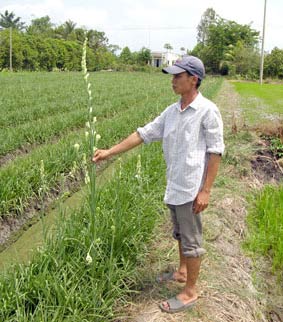Application of biotechnology to create disease-free tuberose sources
Tuberose infected with cotton bottle causes no damage to growers. By cell culture technology for budding tissue, scientists have solved this problem. That is the research result of Dr. Nguyen Bao Toan and his colleagues at Department of Biochemistry, Department of Agriculture and Applied Biology, Can Tho University.
White lily is popular in the Mekong Delta and brings high income for growers, especially on holidays and Tet. Cai Lay district, Tien Giang province is a region with a large area of lily cultivation with nearly 200 hectares per year. People often take seeds using traditional propagation techniques, mainly taking root crops. This has spread the pathogens available in tubers, reducing yield and flower quality. In recent years, lilies are infected with cotton bottle, so bad flowers or flowers are deformed, causing great economic losses for farmers.

The disease-free lily is grown experimentally in the field with a height of about 1.7m.(Photo: Le Huu Hai)
Master Le Huu Hai, Head of Agriculture Department of Cai Lay District, Tien Giang Province, said: 'We have studied some measures to prevent and treat diseases but not effective. We sent the sick lily sample through the Department of Agriculture and Applied Biology, Can Tho University, to find ways to recover or create disease-free varieties. '
According to Dr. Nguyen Bao Toan, chairman of the project "Restoring white lily flower seeds infected by cotton cell technology cultivating bud tissue biology" , the research undergone quite elaborate and meticulous stages. From infected field lily, scientists removed the tuber to isolate bud tissue. Shoots of buds (also called growth peaks) are the ends of buds or roots. When bud shoots develop, it can produce buds, young leaves or flowers. To isolate shoot tissue, the scientists used two methods: direct isolation from shoot tops taken from the field and isolated indirectly from in vitro culture. The bud tissue after isolation, cultured in vitro with growth regulators and nutrients to produce seedlings.
However, seedlings are created in tissue culture medium when carried out directly in the external environment, the mortality rate is very high, due to tissue culture environment and the external environment is very different. Therefore, in order to increase the survival rate of plants when brought out, the tree must undergo gradual adaptation to new environmental conditions. This stage is called taming seedlings. After being domesticated in a net house, the seedlings were experimentally planted in the field, in a net house of Can Tho University, a net house of the Agriculture Department of Cai Lay District, Tien Giang Province. As a result, four lines of tuberose were produced from tissue culture that developed well, normal flowering. The tree has a height of over 1 m, in which many trees reach a height of 1.7 m.
The research results of the project have just been accepted and highly appreciated by the Science Council of Can Tho University. Master Le Huu Hai, Head of Agriculture Department of Cai Lay District, Tien Giang Province, said excitedly: 'From the initial seedlings, we have now bred and have a stable seed source to supply farmers. . In the coming time, Cai Lay District Agriculture Department, Tien Giang province will transfer the disease-free seed to farmers to officially expand in the field '.
COLLECTION
- Self-control of disease-free potato varieties
- Exchange of German-Vietnamese biotechnology experiences
- Application of biotechnology in agriculture
- Indonesia strengthens biotechnology applications
- Breeding Neem plants by cultivating plant tissue
- These applications measure air pollution instead of AirVisual
- Biotechnology improves competitiveness for agricultural products
- Top photo collage application on Android phones for free
- Unexpected energy sources for the future
- Introducing application that supports cardiovascular patients
- Produce becberin by biotechnology
- Many new studies at biotechnology conferences
 'Barefoot engineer' invents a pipeless pump
'Barefoot engineer' invents a pipeless pump Process of handling dead pigs due to disease
Process of handling dead pigs due to disease Radiometer
Radiometer Warp Engine: Technology brings us closer to the speed of light
Warp Engine: Technology brings us closer to the speed of light HYBRiD technology makes tissue transparent: Accelerating future disease research
HYBRiD technology makes tissue transparent: Accelerating future disease research  Breakthrough: Frog regrows amputated leg thanks to special drug
Breakthrough: Frog regrows amputated leg thanks to special drug  Scientists have invented a gel that can heal all body and internal wounds
Scientists have invented a gel that can heal all body and internal wounds  Found the key to opening the immortal door?
Found the key to opening the immortal door?  Use gel from brown algae and soluble polymer to protect donated tissue
Use gel from brown algae and soluble polymer to protect donated tissue  Discover the world's oldest fossil skin in South Africa
Discover the world's oldest fossil skin in South Africa 